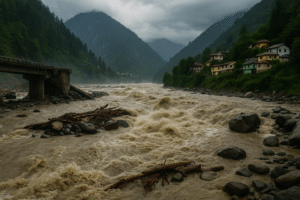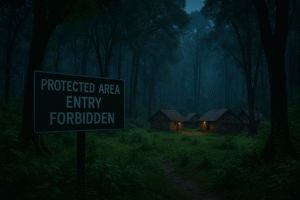In our busy, modern lives, forgetting about the natural world around us is easy. Yet, the environment plays a crucial role in our well-being and survival. One exciting movement gaining momentum is rewilding, which focuses on restoring natural habitats and allowing ecosystems to flourish. Let’s explore rewilding and how it can help restore nature’s balance in India.
What is Rewilding?
Rewilding is returning land areas to their natural, wild state. This often involves reintroducing native species, restoring natural processes, and removing human-made structures that hinder ecosystem health. The goal is to create self-sustaining environments where nature can thrive without constant human intervention.
Rewilding holds great promise in India. The country’s rich biodiversity and varied landscapes are ideal for rewilding projects. From the lush forests of the Western Ghats to the dry landscapes of Rajasthan, each area has unique ecosystems that can thrive with restoration efforts.
Why Rewilding Matters
Rewilding is essential for several reasons. First, it helps combat biodiversity loss. Numerous species face threats from habitat destruction, pollution, and climate change. By restoring natural habitats, rewilding provides a safe haven for wildlife to live and reproduce.
Second, rewilding helps restore ecological balance. Healthy ecosystems provide numerous benefits, including clean air and water, fertile soil, and climate regulation. When nature is allowed to function correctly, these services are naturally restored.
Finally, rewilding offers a chance to reconnect with nature. In a rapidly increasing world of urbanization, having wild spaces can improve our mental and physical health. It provides opportunities for education, recreation, and a deeper appreciation for the natural world.

Rewilding in India
India is home to several rewilding initiatives demonstrating the power of restoring natural habitats.
The Mothi Rewilding Project
The Mothi Rewilding Project, located in Maharashtra, is focused on restoring the region’s dry deciduous forests. The project involves planting native tree species, creating water bodies, and removing invasive plants. These efforts have led to the return of various wildlife species, including deer, birds, and insects, creating a thriving ecosystem.
The Vultures of Rajasthan
In Rajasthan, a rewilding initiative aims to bring back the critically endangered vultures. These scavengers are crucial for the ecosystem, as they help dispose of animal carcasses and curb the spread of diseases. Conservationists are working to boost vulture populations and restore ecological balance by creating safe habitats and breeding programs.
The Western Ghats Biodiversity Project
The Western Ghats, recognized as a UNESCO World Heritage Site, is a critical area for biodiversity. Rewilding efforts here focus on restoring forests, protecting rivers, and reintroducing native species. These actions help maintain the region’s rich biodiversity and support the livelihoods of local communities who depend on natural resources.
How to Get Involved in Rewilding
You might wonder how you can contribute to rewilding efforts. Here are a few steps to get started:
Educate Yourself
Learn about rewilding and the specific needs of your local ecosystem. Understanding the challenges and opportunities will help you make informed decisions and act effectively.
Support Local Projects
Many rewilding initiatives rely on volunteers and donations. Look for local organizations and projects focusing on ecological restoration and lend your support, whether through time, money, or resources.
Create Wildlife-Friendly Spaces
Even small actions can make a big difference. Plant native species in your garden, create animal water sources and avoid using pesticides. These steps can help develop mini-habitats that support local wildlife.
Advocate for Policy Changes
Encourage policymakers to support rewilding efforts and conservation projects. Advocate for the conservation of natural habitats and the adoption of sustainable practices.
Success Stories in Rewilding
The Tiger Resurgence in Sariska
Sariska Tiger Reserve in Rajasthan saw a significant decline in its tiger population due to poaching and loss of habitat. However, through rewilding efforts, including habitat restoration and strict anti-poaching measures, the tiger population has started to recover. This success story highlights the importance of coordinated conservation efforts.
The Return of the Indian Wolf in Gujarat
In Gujarat, rewilding efforts have focused on creating safe corridors for the Indian wolf. These initiatives have helped increase the wolf population and restore ecological balance by connecting fragmented habitats and reducing human-wildlife conflicts.
The Grassland Revival in Madhya Pradesh
In Madhya Pradesh, rewilding projects have aimed to restore degraded grasslands. By reintroducing native grass species and managing grazing practices, these efforts have led to the return of herbivores like the blackbuck, creating a healthier and more balanced ecosystem.
The Future of Rewilding in India
The potential for rewilding in India is vast. With its diverse ecosystems and rich biodiversity, the country has the opportunity to lead the way in ecological restoration. By investing in rewilding projects, supporting local communities, and fostering a culture of conservation, we can create a sustainable future where nature thrives.
Rewilding also has the potential to provide economic benefits. Ecotourism, sustainable agriculture, and natural resource management can create jobs and support local economies. By appreciating and safeguarding our natural heritage, we can create a resilient and thriving future.
Conclusion
Rewilding offers a hopeful vision for the future, where nature’s balance is restored, and ecosystems can flourish. In India, rewilding initiatives are already making a significant impact, demonstrating the power of nature to heal and regenerate.
As individuals, we can support these efforts by educating ourselves, getting involved in local projects, and advocating for policies that protect natural habitats. Together, we can make a difference and help create a world where nature thrives.
Author’s Note:
Thank you for reading! This blog inspires you to learn more about rewilding and get involved in efforts to restore nature’s balance. Let’s work together to protect our planet.
G.C., Ecosociosphere contributor.




